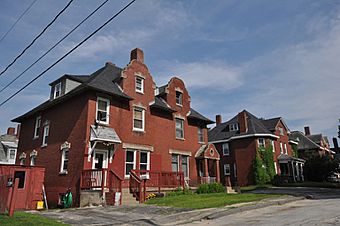Strathglass Park District facts for kids
Quick facts for kids |
|
|
Strathglass Park District
|
|
 |
|
| Lua error in Module:Location_map at line 420: attempt to index field 'wikibase' (a nil value). | |
| Location | Bounded by Lincoln Ave., Hancock St., Maine Ave., and York St., Rumford, Maine |
|---|---|
| Area | 23 acres (9.3 ha) |
| Built | 1902 |
| Architect | Cass Gilbert; Gay, W. W. |
| Architectural style | Shingle |
| NRHP reference No. | 74000181 |
| Added to NRHP | October 18, 1974 |
The Strathglass Park District in Rumford, Maine, is a special neighborhood. It's known as one of the best places where mill workers lived in the early 1900s.
A man named Hugh J. Chisholm owned a paper mill in Rumford. He paid for these homes to be built. A famous architect, Cass Gilbert, designed them.
The district has 50 high-quality brick houses. They are all duplexes, meaning each building has two separate homes. They were built between 1901 and 1902. The homes are on tree-lined streets with a small park in the middle.
In 1974, Strathglass Park was added to the National Register of Historic Places. This means it's an important historical site. Most of the houses were sold to the people living in them in the late 1940s.
Contents
What Makes Strathglass Park Special?
The Strathglass Park District is in the center of Rumford. You can find it between Lincoln Avenue, Hancock Street, Maine Avenue, and York Street. The main way to enter the area is through a stone gate on Maine Avenue. From there, three streets spread out, ending at Clachan Place.
There's a small park near the north end on Lochness Road. This road is the middle one of the three main streets. All the homes here are duplexes and are made of brick.
The Unique Style of the Homes
The houses mostly have a style called Shingle style. But you can also see parts of Queen Anne and Dutch Revival styles. The bricks used for the houses were made right there in Rumford. The slate for the roofs came all the way from Vermont and Pennsylvania by train.
The walls of the houses were built with empty spaces inside. This helped keep the homes warm in winter and cool in summer. The rooms inside were quite large. This was very different from many other worker homes at the time, which were often small and crowded.
The homes also had hardwood floors, which were easy to clean. Plus, the Rumford Falls Power Company, also owned by Chisholm, provided electricity for a very small fee.
Why Was Strathglass Park Built?
Hugh J. Chisholm started his paper mill in Rumford in the 1880s. He had seen how bad worker housing was in big industrial cities. He wanted to attract good workers to his mill. So, he decided to offer them much better places to live.
He hired New York City architect Cass Gilbert to design the buildings. Chisholm named the area "Strathglass" after a river in Scotland. This river was near his family's old home, Erchless Castle. Even the street names in the neighborhood are Scottish!
Living in Strathglass Park
When the houses were ready, the company gave them to employees. These employees were recommended by their bosses. The rent was very low, just enough to cover costs.
The company also helped with services like removing snow, mowing lawns, and taking away trash. In 1948 and 1949, the company sold the homes. Most of the people living in them bought their houses.
Images for kids


